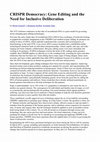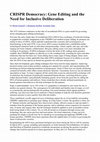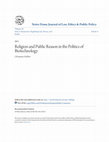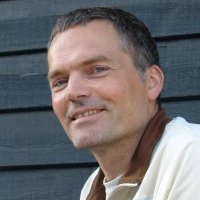Book chapters by J. Benjamin Hurlbut
Handbook of Science and Technology Studies (4th edition), 2016
Papers by J. Benjamin Hurlbut
Springer eBooks, 2023
The last name of J. Benjamin Hurlbut was unfortunately published with an error. The initially pub... more The last name of J. Benjamin Hurlbut was unfortunately published with an error. The initially published version has now been corrected.

The 1975 Asilomar conference on the risks of recombinant DNA is a poor model for governing newly ... more The 1975 Asilomar conference on the risks of recombinant DNA is a poor model for governing newly emerging gene-editing technologies. Not since the early, heady days of recombinant DNA (rDNA) has a technique of molecular biology so gripped the scientific imagination as the CRISPR-Cas9 method of gene editing. Its promises are similar to those of rDNA, which radically transformed the economic and social practices of biotechnology in the mid-1970s. Ivory tower rDNA science morphed into a multibillion dollar technological enterprise built on individual entrepreneurship, venture capital, start-ups, and wideranging university-industry collaborations. But gene editing seems even more immediate and exciting in its promises. If rDNA techniques rewrote the book of life, making entire genomes readable, then CRISPR applies an editorial eye to the resulting book, searching for typos and other infelicities that mar the basic text. Gene editing shows many signs of being cheaper, faster, more accurate, and more widely applicable than older rDNA techniques because of its ability to cut and alter the DNA of any species at almost any genomic site with ease and precision.

The 1975 Asilomar conference on the risks of recombinant DNA is a poor model for governing newly ... more The 1975 Asilomar conference on the risks of recombinant DNA is a poor model for governing newly emerging gene-editing technologies. Not since the early, heady days of recombinant DNA (rDNA) has a technique of molecular biology so gripped the scientific imagination as the CRISPR-Cas9 method of gene editing. Its promises are similar to those of rDNA, which radically transformed the economic and social practices of biotechnology in the mid-1970s. Ivory tower rDNA science morphed into a multibillion dollar technological enterprise built on individual entrepreneurship, venture capital, start-ups, and wideranging university-industry collaborations. But gene editing seems even more immediate and exciting in its promises. If rDNA techniques rewrote the book of life, making entire genomes readable, then CRISPR applies an editorial eye to the resulting book, searching for typos and other infelicities that mar the basic text. Gene editing shows many signs of being cheaper, faster, more accurate, and more widely applicable than older rDNA techniques because of its ability to cut and alter the DNA of any species at almost any genomic site with ease and precision.

Ethics & Medics, 2016
A growing chorus of voices is declaring that CRISPR will revolutionize the ability to control lif... more A growing chorus of voices is declaring that CRISPR will revolutionize the ability to control life, including human life. As genetically altering future generations becomes technically realistic, it raises the prospect of genetic enhancement and the specter of eugenics. Prominent scientists are calling for international guidelines to govern human applications of gene-editing technology. They argue that the technical possibility of human germline gene editing makes ethical deliberation urgent. Now that the technology is upon us, the time has come to ask whether we want it. Human germline genetic engineering has long been marked as a morally significant boundary, and in numerous countries it is explicitly prohibited by law. The Oviedo Convention, a legally binding treaty among twenty-nine European countries, prohibits it as a violation of human rights and dignity. Nevertheless, numerous commentators argue that prohibitions made before it was technically possible meant little, and past...

Notre Dame Journal of Law, Ethics & Public Policy, 2015
Questions about the relevance of religious views to public policy have been central in debates ov... more Questions about the relevance of religious views to public policy have been central in debates over the governance of biotechnology since the 1960s. This article offers an empirical analysis of moments of deliberative politics surrounding human embryo research, primarily within public bioethics bodies. I examine how these bodies have used the idea of public reason as developed in deliberative democratic theory to differentiate between secular and religious reasons. I argue that scientific authority is made to play a powerful, but largely unacknowledged role in constructing these categories by contributing to definitions of the range of “reasonable” pluralism. I show that notions of right (scientific) knowledge are co-produced with ideas of how public discourse can be disciplined to comport with an ideal of public reason. I argue that scientific authority powerfully shapes the contours of public deliberation in ways that are highly consequential for notions of democratic legitimacy, ...
Experiments in Democracy
Chapter 5 examines the politics surrounding George W. Bush’s embryonic stem cell policy, and in p... more Chapter 5 examines the politics surrounding George W. Bush’s embryonic stem cell policy, and in particular debates over what terms should be used in public debate about human cloning. It examines the approach of the President’s Council on Bioethics to ground its deliberations in a shared language that would open up space for ethical disagreement, rather that limit it in the name of producing consensus. The Council’s project of finding a common language was appropriated by a group of scientists who set about to reform the language employed in public deliberation.
Experiments in Democracy
Chapter 1 examines the period from the mid-1960s to 1980. During this period, scientific advances... more Chapter 1 examines the period from the mid-1960s to 1980. During this period, scientific advances made in human in vitro fertilization and embryo culture led to the birth of Louise Brown, the first child conceived through IVF, in 1978. The chapter examines the deliberations of two federal bioethics bodies: the National Commission for the protection of Human Subjects of Behavioral and Biomedical research, and the Ethics Advisory Board of the Department of Health, Education and Welfare.
<p>Chapter 3 examines events of the early 1990s, focusing in particular on the deliberation... more <p>Chapter 3 examines events of the early 1990s, focusing in particular on the deliberations of the National Institutions of Health Human Embryo Research Panel (HERP). The National Institutes of Health established the HERP after congress passed legislation that ended a de facto moratorium on federal funding for human embryo research. The chapter demonstrates how the Panel drew on John Rawls' theory of public reason to construct an account of public reason that privileged scientific authority, and examines the political and policy reactions to the Panel's recommendations.</p>
Experiments in Democracy, 2017
Chapter 2 examines how during the 1980’s the in vitro embryo went from a rare laboratory object t... more Chapter 2 examines how during the 1980’s the in vitro embryo went from a rare laboratory object to an element of widespread clinical practice. In response to the rapid growth of this largely unregulated industry the American Fertility Society created an Ethics Committee in 1985. The chapter examines the deliberations of that committee, including how it created a new scientific term—the “preembryo”—to shape public discourse.
Bioeconomies, 2017
Science is the highest personification of the nation because that nation will remain the first wh... more Science is the highest personification of the nation because that nation will remain the first which carries the furthest the works of thought and intelligence.-Louis Pasteur IntroductIon In 2010 when J. Craig Venter announced that he had created "synthetic life," the Guardian ran an article with the headline "synthetic life breakthrough could be worth over a trillion dollars." The breakthrough technology was a bacterium with a synthetic genome whose purpose was to demonstrate the feasibility of converting a simple organism into a flexible industrial platform by installing new genetic "software." It was the product of "Venter's ambition to create organisms that are not only new, but lucrative" (Sample 2010).
Beyond Bioethics, 2019
On April 3 2015, a group of prominent biologists and ethicists writing in Science called for a mo... more On April 3 2015, a group of prominent biologists and ethicists writing in Science called for a moratorium on germline gene engineering; modifications to the human genome that will be passed on to future generations. The moratorium would apply to a technology called CRISPR/Cas9, which enables the removal of undesirable genes, insertion of desirable ones, and the broad recoding of nearly any DNA sequence.
Experiments in Democracy, 2017
Experiments in Democracy, 2017

One of the core problematics of the biotechnology revolution has been defining its relationship t... more One of the core problematics of the biotechnology revolution has been defining its relationship to human life. This paper explores the question of whether science can remain human by interrogating some of the ways that the figure of the human has been rearticulated and transformed in the context of the biosciences. Accounts of what the human is in debates about biotechnology have mostly focused on the human as an object of technological intervention and control. In this chapter, I take the work of “figuring the human” itself as my object of analysis. I see “the human” as at stake both in the sense of quintessence and as a discursive figure that is made and remade in giving articulation to human quintessence and in calibrating action accordingly. These two dimensions, i.e. the ontological and the discursive, cannot be separated because the modes of political engagement are essential enactments of human life. The chapter explores three registers in which these modes have played out: (...








Uploads
Book chapters by J. Benjamin Hurlbut
Papers by J. Benjamin Hurlbut